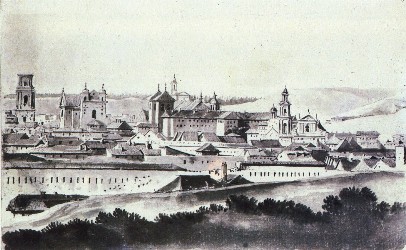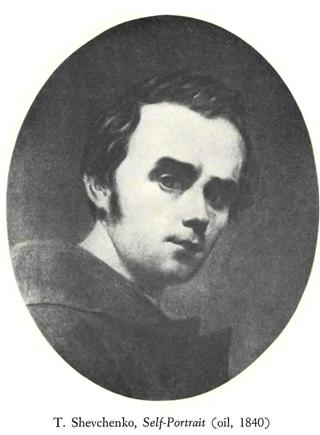TARAS SHEVCHENKO’S LIFE AND WORK
Youth of Taras Shevchenko
(C.H. Andrusyshen, biography of T. Shevchenko in English)
(Introduction of "The poetical works of Taras Shevchenko. The Kobzar" by Constantine Henry Andrusyshen and Watson Kirkconnell)
After the death of Count Vassil Engelhardt, his son Paul inherited the landed property together with all its chattels and serfs. Presently the fourteen-year-old Taras was taken into the palace in the nearby town Vilshana to serve as a helper to the cook, but, failing in the kitchen, he was transferred to the apartments to attend his lord as a lackey. However, he was not to be pinned down to drudgery, and whenever he could he would escape to pass his time secretly in musings, drawing, and painting, especially at night when he could not be detected. Once, however, he was surprised by the lord at sketching and was mercilessly beaten for running the risk of setting the house on fire by burning the midnight oil. The next day he was soundly birched to boot. This happened in Vilna, where P. Engelhardt was living, together with his suite, as an adjutant to the Russian governor of the province of Lithuania. However painful the incident may have been, it marked a turning point in the budding artist's life, for it finally dawned on the master that his footman was talented indeed and warranted lessons from a competent teacher. And so in 1830 began his formal art studies at the studio of Jan Rustan of Vilna.

Vilnius city panorama, 1785
Painted by Franciszek Smuglewicz
(Pranciskus Smuglevicius)
With that breakthrough, he was free to visit whatever architectural monuments he wished in that Lithuanian town. It proved a boon to him in another respect, for in the course of his rambling observations, in the Gothic Church of St. Anne he met a young lady, Dunia Husikovska, a Pole. With her he began a romantic friendship which, however, did not last long, for that very year he had to follow his master to Warsaw.
 Shevchenko's painting
Shevchenko's painting
"Bust of Woman", or "Female head"
A copy of the original unknown
Paper, pencil Italian, 1830
In the Polish capital, Engelhardt sent Taras to study painting under Franz Lampi, the first top-notch teacher he had had thus far, and a man who inspired in the youth a love for Classical art. But his Warsaw sojourn was also short-lived. As a result of the imminent Polish insurrection against the tsarist regime (1831), Engelhardt and his entire entourage had to flee to Russia; and it was in St. Petersburg that young Shevchenko finally became fixed as he reverted to the degrading status of a footman to his owner. In this position he proved so utterly disappointing that Engelhardt, probably out of sheer exasperation, was forced to accede to the youth's entreaties to be allowed to continue his art studies under the painter, V. Shiryayev. That arrangement proved lucrative to the lord, as he was able to draw monetary profit from his serfs work.
Shiryayev was a crude and cruel taskmaster, but it was impossible for Shevchenko to escape from his ferule because he was contracted to remain as his assistant for a period of four years. The high-handed treatment notwithstanding, the eager learner considered himself fortunate to be able to further his theoretical and practical studies. After long hours, spent mostly in decorating the ceiling of the St. Petersburg Bolshoi Theatre, he would often go out at night to the Summer Garden and there, under the bright northern skies, enjoy and edify himself by sketching the figures of the gods and goddesses who adorned the allees of the park.
There he met a countryman of his, Ivan Soshenko, a student at the Academy of Art, who immediately formed a close friendship with him, encouraged him to paint water-colour portraits, and gave him personal instruction in their execution. Through him Shevchenko was introduced to the Ukrainian writer-fabulist, Evhen Hrebinka, who supplied him with Ukrainian books that inspired him with love for his country's historical and folklorist past. The literary soirees arranged by this author proved especially beneficial to the young artist about to become a poet.
Introduction written by Professor C.H. Andrusyshen
Source: The Poetical Works of Taras Shevchenko. The Kobzar. Translated from the Ukrainian by С.H. Andrusyshen and Watson Kirkconnell. Published for the Ukrainian Canadian Committee by University of Toronto Press, 1964. Toronto and Buffalo. Printed in Canada, Reprinted, 1977, p. 12 - 13.
Read more:

Introduction of "The poetical works of Taras Shevchenko. The Kobzar" by Constantine Henry Andrusyshen and Watson Kirkconnell.

 Shevchenko's painting
Shevchenko's painting